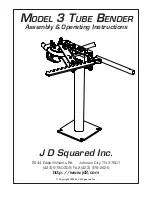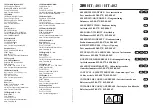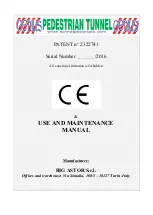
6
6
•
Adequate airway pressure via endotracheal (NOT mouth-to-nose) ventilation will
activate the “correct ventilation” light on the control box.
•
Appropriate hand placement on the chest will activate the “correct position” light.
•
Appropriate chest pressure will activate the “correct compression” light.
•
The red “error” light or optional audio signal indicates excessive chest pressure.
TRAINING WITH THE
Life
/
form
®
CPR DOG
CPR should always be performed from the back of the dog with the animal lying on its right
side (left side UP). Place the dog on a firm, nonslip surface.
Mouth-to Nose Ventilation
Clamp the dog’s mouth shut with both hands and blow gently into the nose. Watch for chest
to rise. Do not over-inflate. The “correct ventilation” light on the control box will not activate
during mouth-to-nose ventilation.
Endotracheal Ventilation
Establish an airway by inserting a 6 mm or 6.5 mm lubricated cuffed endotracheal tube into
the simulated trachea at the back of the throat. The cuff on the ET tube must be inflated with
a 12 cc syringe. The “correct ventilation” light on the control box will illuminate with proper
ventilation. Chest rise is visible only with the mouth-to-nose method.
Chest Compression
Place your hands on the dog’s chest just behind the shoulder, at the point where the left elbow
would meet the body if the leg were pulled backward. Use the heel of your hand to activate the
position light. Compressions and ventilations should be performed according to prescribed
standards (current guidelines). Avoid excessive pressure, as this may damage the trainer.
Resuscitation may be practiced with one person or two, with one performing compressions
while the other ventilates.
Figure 6
•
Adequate airway pressure via endotracheal (NOT mouth-to-nose) ventilation will
activate the “correct ventilation” light on the control box.
•
Appropriate hand placement on the chest will activate the “correct position” light.
•
Appropriate chest pressure will activate the “correct compression” light.
•
The red “error” light or optional audio signal indicates excessive chest pressure.
TRAINING WITH THE
Life
/
form
®
CPR DOG
CPR should always be performed from the back of the dog with the animal lying on its right
side (left side UP). Place the dog on a firm, nonslip surface.
Mouth-to Nose Ventilation
Clamp the dog’s mouth shut with both hands and blow gently into the nose. Watch for chest
to rise. Do not over-inflate. The “correct ventilation” light on the control box will not activate
during mouth-to-nose ventilation.
Endotracheal Ventilation
Establish an airway by inserting a 6 mm or 6.5 mm lubricated cuffed endotracheal tube into
the simulated trachea at the back of the throat. The cuff on the ET tube must be inflated with
a 12 cc syringe. The “correct ventilation” light on the control box will illuminate with proper
ventilation. Chest rise is visible only with the mouth-to-nose method.
Chest Compression
Place your hands on the dog’s chest just behind the shoulder, at the point where the left elbow
would meet the body if the leg were pulled backward. Use the heel of your hand to activate the
position light. Compressions and ventilations should be performed according to prescribed
standards (current guidelines). Avoid excessive pressure, as this may damage the trainer.
Resuscitation may be practiced with one person or two, with one performing compressions
while the other ventilates.
Figure 6
HC190001INM9.indd 11-12
1/16/19 8:44 AM
Содержание Life/form LF01155U
Страница 2: ......




























